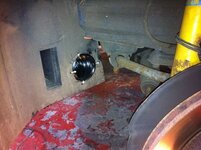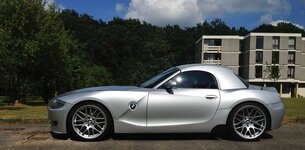By popular demand...sorry for the delay.
As i've said elsewhere, brake temperature is heavily influenced by the friction coefficient of the pad and the pad's initial bite. Whilst the amount of kinetic energy being converted into heat remains the same, the lower the pedal pressure applied to the pad and the shorter the period of time that the brakes are applied the lower the brake temperatures will be. The exact physics mechanism for this i do not understand but is the generally accepted rule. I have been in extended dialogue with a brake pad manufacturer, but they were not able to explain it in a way i understand.
My mistake was finding a pad that worked well at all temperatures, specifically the Ferodo DS2500. This pad has a higher coefficient of friction than OEM which allows a lower pedal pressure and improved braking, but it isn't quite good enough. Its friction coefficient remains constant even when the pad temperature has increased way beyond what would cause other pads to fade. The net result of that is you have no idea that your brakes, specifically the discs, are overheating as there just isn't any fade and braking performance remains strong. This is why i was driving round the track with my discs glowing under braking but having no idea. If you get cast iron brake discs hotter than 600 degrees for any length of time you risk the disc cracking, which is exactly what happened in my case on a number of occasions. Floating type discs, as per the Z4m, are much less prone to cracking because they are more able to expand and contract freely whereas a solid bell type disc is constrained by the hub.
My initial mistake was to try to compensate for the heat problems with better discs and better cooling when i should have looked more at the pad itself.
I ended up using a Dixcel pad which had an even higher coefficient of friction than the DS2500. This meant that you had to be very gentle with the brake pedal as the pedal pressures for normal braking were very low. But even with extreme on track braking over an extended period of time the discs were running somewhere around the 450 degrees Celcius mark at their peak. Braking performance was phenomenal and on the S2000 this is the pad that the racers and serious trackday drivers use. No upgrade to the brake cooling or to the single pot caliper is required. Just upgraded pads, a slightly better disc and higher boiling point Dot4 brake fluid and the brakes provide exceptional and fade free performance.
The downside was the price. They were roughly double the price of the Ferodo's and very hard on the discs. You'd need to replace the discs for every other set of pads.
I'd love to know the details of the Dixcel compound as they don't make pads for the Z4M.
For those people who's pads are wearing out excessively quickly on trackdays, one of two things are happening.
Firstly, the pad may just not be able to cope with the temperatures it is experiencing. That's where brake cooling helps if you can't change to a better pad.
Secondly, the pads may not have been bedded in and heat cycled properly.
The pad compound is held together with resin binders and when these get hot they produce a gas which has to work its way out of the pad. If the pad gets too hot too quickly the gases cannot diffuse out of the pad quickly enough and it has the effect of separating the grains of the pad compound and in extreme cases blowing the pad apart. You can often see this because the pad will be crumbly and will fall apart to the touch.
Decent pads will either be heat cycled in an oven as part of the manufacture process and don't need heat cycling or will have specific bedding instructions which normally involve a fixed number of braking cycles from one speed to another followed by a cooling period followed by the process being repeated again.
Exdos's brake duct cooling mod will only help with all of the above.



 The thought had never occurred to me, but now you mention it, will you be my campaign manager?
The thought had never occurred to me, but now you mention it, will you be my campaign manager?

